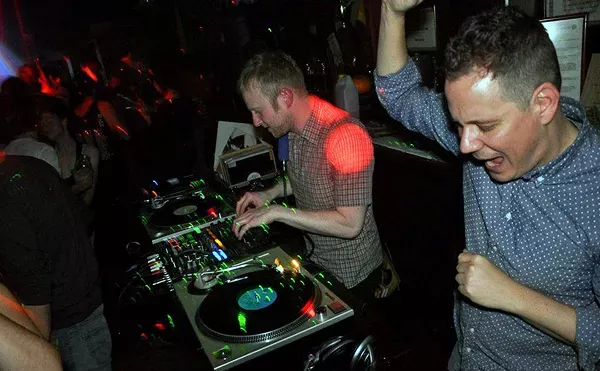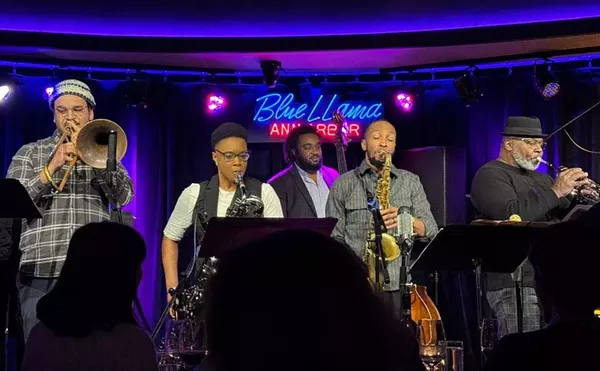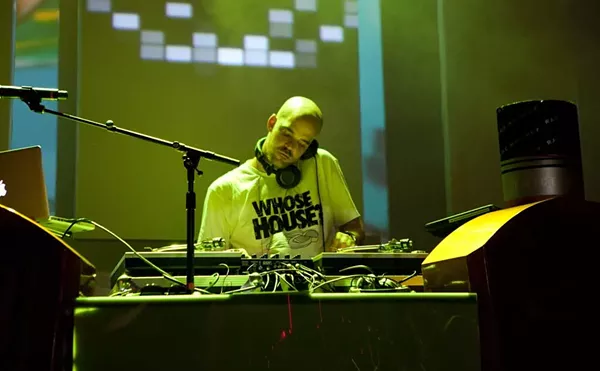This year's Detroit Jazz Fest has daily slots for Charlie Gabriel's New Orleans Traditional Jazz Band to evoke some of the deepest roots of the genre. The band does the Second Line, a cross between a parade and a street dance that, for generations, has led New Orleans funeral mourners away from the grave and back to a celebration of life.
But the first band to actually hit a stage, the Michigan State University Jazz Orchestra I, is set to present audiences with one of the newer traditions in the form of a suite based on Marvin Gaye's classic "What's Going On." Serious jazz artists today are more accepting of and interested in revisiting the pop repertoire than at any time in the last half century.
Gershwin still swings with "I've Got Rhythm" and innumerable pieces based on its chord changes. Cole Porter is still the top. Ellington, Monk and Mingus are still composer-deities. But too many artists to keep track of these days are inserting the Beatles and Blondie, Prince and Tears for Fears, Sade and Björk into their personal repertoires.
"It's the 21st century and we can't just be stuck playing Ellington," says bassist Rodney Whitaker, who heads the jazz program at Michigan State University. He'll be leading the MSU ensemble in the suite arranged by his saxophonist colleague, Diego Rivera.
Among the artists echoing that sentiment is festival performer Don Byron whose current band is billed as "the Junior Walker Project" — an outgrowth of his 2006 disc Do the Boomerang, a tribute to the Motown saxophonist.
"What do, like, really straight jazz musicians think? They think they wouldn't make a record like that. But it's not really their business that I made an R&B record," says Byron, who's also recorded in styles from klezmer to Latin jazz. "Ultimately when you make a record like that you get to entertain some of the people who like that stuff and don't like jazz. And I like to entertain."
"The thing is to be honest to search because when people stop trying to move the music forward — or art forward — that says something about us as a people. Are we not moving forward?" says violinist Regina Carter on the same topic.
It's not as if jazz and pop have ever entirely gone separate ways. What we now call "jazz" and "pop" were pretty much joined at the loins through the 1930s and increasingly split off through the 1940s. In the 1950s and afterward, the changing nature of pop music contributed to the divide. The younger songwriters and recording artists were less likely to draw on the rich, jazzy harmonies that defined the Tin Pan Alley era. When Miles Davis spearheaded the rock-jazz fusion movement as the '60s turned into the '70s, he brought rock and funk rhythms and electronic instruments into jazz, but he wasn't much interested in popular tunes.
Of course, there were always some bridges — some successful, some not. Wes Montgomery did "A Day in the Life." Burt Bacharach has always found jazz-world admirers. Ella Fitzgerald recorded a killer version of "Sunshine of Your Love." Late in his career, Miles did the same with live recordings of Cyndi Lauper's "Time After Time" and of Michael Jackson's "Human Nature" (the latter featuring a show-stopping saxophone solo from festival performer Kenny Garrett).
Cass and Herbie
The sea change, Whitaker observes, came in a couple of recordings in the mid-'90s. First there was singer Cassandra Wilson's Blue Light Til Dawn, featuring a cast of jazz musicians like herself interpreting material that ranged from tunes often recorded by jazz artists (such as "You Don't Know What Love Is"), to Robert Johnson blues classics, to Van Morrison's "Tupelo Honey" and Ann Peebles' soulful "I Can't Stand the Rain." And while Wilson is widely credited with changing the repertoire for singers — it's hard to imagine a Norah Jones without Wilson — Whitaker says her influence went further.
Like a lot of musicians in his generation, says Whitaker, who was born in 1968, "I grew up as a jazz musician seeing all the guys playing funky stuff and liking that and feeling as if I had to deny that in some way to be accepted as a jazz musician. It's a weird thing."
Wilson's record, he recalls, "changed a lot of our minds. That's when everybody started talking about 'the new standards.' And then Herbie Hancock came out with a record called The New Standard. That kind of opened the door for all of us to look at repertoire that we previously ignored."
Hancock isn't playing material from that disc these days. His current band, which plays the Detroit fest, is performing a sort of career retrospective, emphasizing not so much the old standards, or the new standards as the Hancock standards, going back to the '60s (with "Maiden Voyage" and "Cantaloupe Island"), reliving his 1970s from the Head Hunters band (with tunes like "Chameleon" and "Watermelon Man") and on through his most recent disc, Possibilities (which, in keeping with the new standards idea, does feature collaborations with artists from Paul Simon to Angélique Kidjo).
Hancock admits that he was initially wary when a label exec suggested he record contemporary pop material: "I said I don't want to do anything that smells of being commercial and sell records just because these are songs that are big celebrity names today. But because of having worked with Miles Davis, I hate to just take something that seems impossible and just leave it at that."
The trick, says Hancock, was "taking songs by contemporary artists and reworking them. The old standards were the same harmonies we used in jazz. Well, in rock 'n' roll, the harmonies are a lot simpler, and so I had to restructure the songs that I chose, to put my own spin on them, as a jazz player." He recorded Prince, the Beatles, Peter Gabriel and others, and he notes, "In a lot of cases, they don't even sound like the same pieces."
In a sense, he set a high standard for a movement that his disc helped to name.
Motown melodies
When musicians refer to the "simpler" harmonies of post-'60s pop music versus the old standards, they invariably add that they're speaking in general, and Motown is one of the prominent exceptions. "I didn't have to restructure Stevie Wonder," Hancock says. That was a matter of choice, not necessity on The New Standards. Classic Motown — as much of the world finally knows after the movie Standing in the Shadows of Motown made the Funk Brothers famous — was a sound based on a core of cats from the city's fabled jazz scene. From composition, to arrangement to performance, classic Motown tunes were influenced to some extent by jazz.
So Motown as new standard material would seem natural in Detroit. But the embrace has been long in coming. What transpired is as complicated as Motown itself.
Whitaker recalls coming up under musicians like trumpeter Herbie Williams, who jammed alongside Charlie Parker and went on to help make Berry Gordy a multimillionaire. Musicians like Williams remembered well the destruction of the old Black Bottom neighborhood and the club district along Hastings Street, ultimately making way for the Chrysler Freeway, in the late '50s. After the old jazz scene crumbled, says Whitaker, musicians connected Motown with "the death of jazz."
Then there was the way Motown treated its musicians — paying them poorly in the early days, keeping them cloaked in anonymity when some of their counterparts elsewhere were being publicly praised — and, ultimately, the way the label was seen as abandoning the city and its musicians when it moved to California.
"I can't imagine how that felt," says Carter, an ex-Detroiter and one of Whitaker's peers, who is a featured headliner of this year's festival. "You're a part of why that sound is, a part of what it is. Then Berry just pulled up Motown to leave them. It had to feel like a slap in the face."
In fact, Whitaker says, last year, when MSU awarded Gordy an honorary doctorate, all those old feelings were stirred up anew. "I got hate mail from Detroit folk, jazz folk," says Whitaker. "They were like, 'Man, how could you honor him. He abandoned the city in the middle of the night.'"
Drummer Spider Webb travels regularly with the Funk Brothers these days, and Wednesdays and Thursdays, he's with the S-B-H Trio, anchoring jam sessions at Bert's Marketplace. Back in the day, he played on such Motown classics as "Cloud Nine." He agrees that lots of musicians "really suffered" when the company moved.
Webb points to something else that kept Motown from crossing into the jazz repertoire, even here in Detroit. In addition to their feelings about the way musicians were treated by the company, Webb says it's taken years — and things like the film Standing in the Shadow — for some of musicians to grasp the impact that Motown actually has had on the world.
"Shotgun"
But for Detroit musicians of Whitaker's generation, Motown is music first. "We see it as, 'That's our story, that's our soundtrack.'" And he figures that most of his Detroit peers who make records have cut a Motown track at one time or another.
Regina Carter did a couple on her Motor City Memories CD a few years back and pulls them out from time to time, especially for extended club engagements.
In the band he co-leads with drummer Carl Allen, Whitaker recorded deft rearrangements of the Temptations' "Get Ready" and Marvin Gaye's "Inner City Blues." The disc, Get Ready, is the Allen-Whitaker outfit's debut for Mack Avenue Records.
Though a New Yorker and a decade older than Whitaker, clarinetist and saxophonist Byron has similar attitudes about Motown. His Junior Walker disc grew out of his interest in Walker's way with the blues. "Most jazz horn players just play some blues changes," says Byron. "The same things that he sings, he plays — and as a horn player, we're weaned to not necessarily be thinking about vocalists."
As to Motown in general, he adds, "It's just like if you're French, you have a certain amount of cultural stuff that you grew up with that's your birthright. So for me — as American musician and an African-American musician — I feel like Motown and Stax-Volt, that's my birthright. If I have a culture, then it's an important part of it."
And across the jazz world, similar thoughts are subtly adding to what jazz musicians play — and what audiences may come to expect: variations and improvisations on tunes that even listeners in their 20s have soaked up from radio and TV and the movies of their time.
The new standards movement isn't for everyone. "None of those tunes harmonically ever got to me," the saxophone player Joe Lovano once said, after listing the Beatles, Motown, Elton John and Billy Joel. Pianist Bill Charlap, a festival performer this year, was quoted saying that Stevie Wonder and Marvin Gaye are a "genius" and "beautiful," respectively, but he's content sticking with 50 or so classic writers on a list that begins with the likes of Gershwin, Berlin and Porter. "We're toiling in a different field," he said.
And, it's worth noting that although the new standards may have been hits as pop, it's hard to think of even one that's been universally accepted among jazz musicians — that is, a jam session lingua franca like "I Got Rhythm" or Horace Silver's "Song for My Father" that a musician can call out anywhere jazz is played and expect others to join in.
The movement shows no signs of taking over — but there are no signs of it slowing down, either.
Whitaker, a recording session regular, says, "Every date that I do with folk, everybody has a new standard. They have a tune that they grew up on that they rearranged and reharmonized into a jazz format. I just did a date in New York with a guy who wrote an arrangement for some O'Jays tunes that I would have never thought could be adapted into a jazz format. And he did a beautiful job of putting it together."
Whitaker is looking at recording renditions of "Dancing in the Streets" and Stevie Wonder's The Secret Life of Plants, and there's a treatment in the works of Stevie Wonder's Songs in the Key of Life album at MSU.
Over the coming days, alongside both the MSU big band and his group with Allen, Whitaker gets to see how these Motown new standards go over in the city where they were first created. And rest assured, over the next few days, there'll be other new standards played aplenty.
The Michigan State University Jazz Orchestra I performs at 5:30 p.m. Friday at the Here & Now Stage on Larned near Woodward. Herbie Hancock performs at 8:45 Friday at the Chase Main Stage. Don Byron's Junior Walker Project performs at 7:30 Sunday at the Mack Avenue Pyramid Stage. The Carl Allen-Rodney Whitaker Project performs at 5 Monday at the Absopure Watefront Stage. Full schedule information at detroitjazzfest.com.
W. Kim Heron is editor of Metro Times. Send comments to [email protected]






